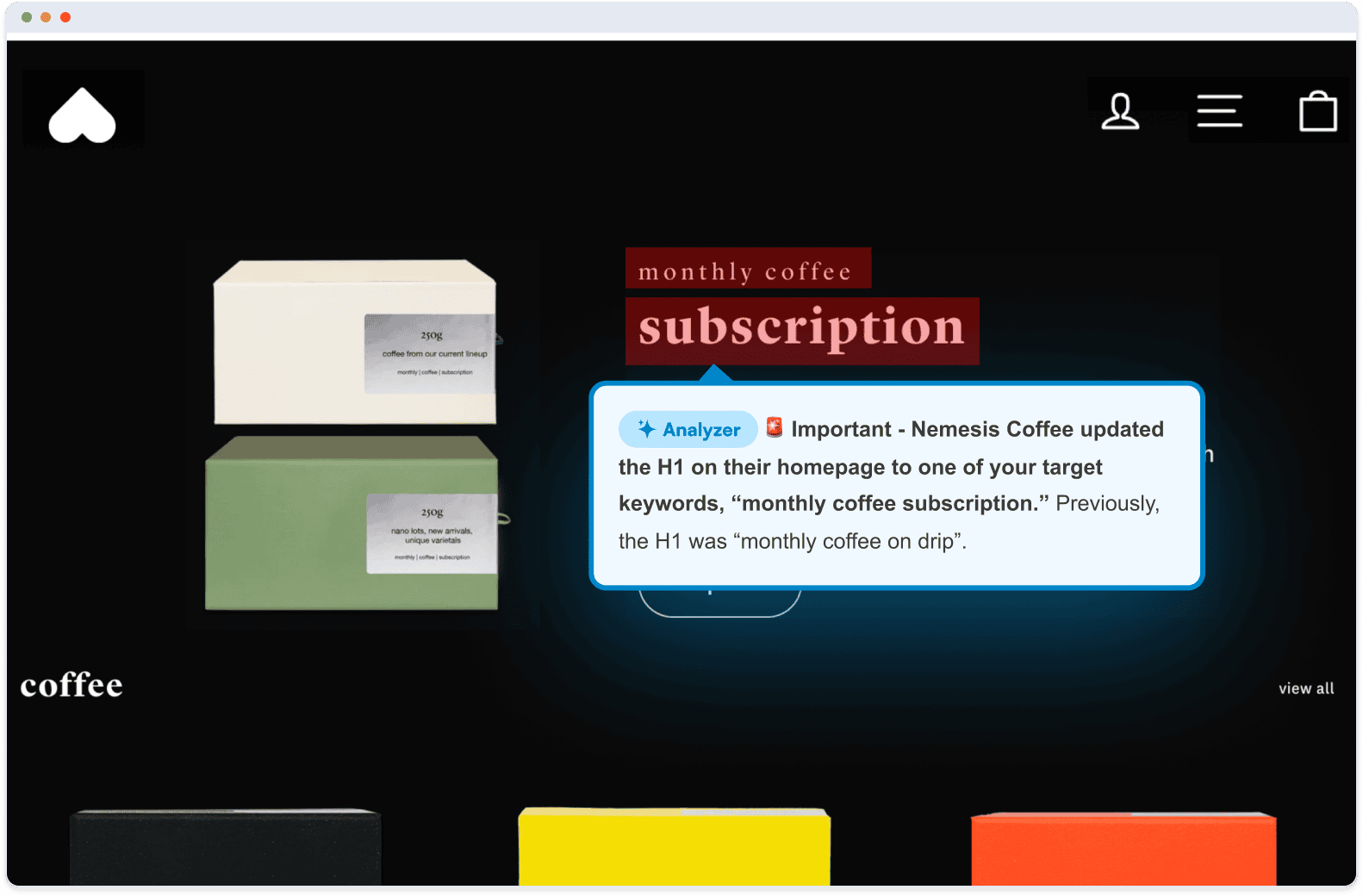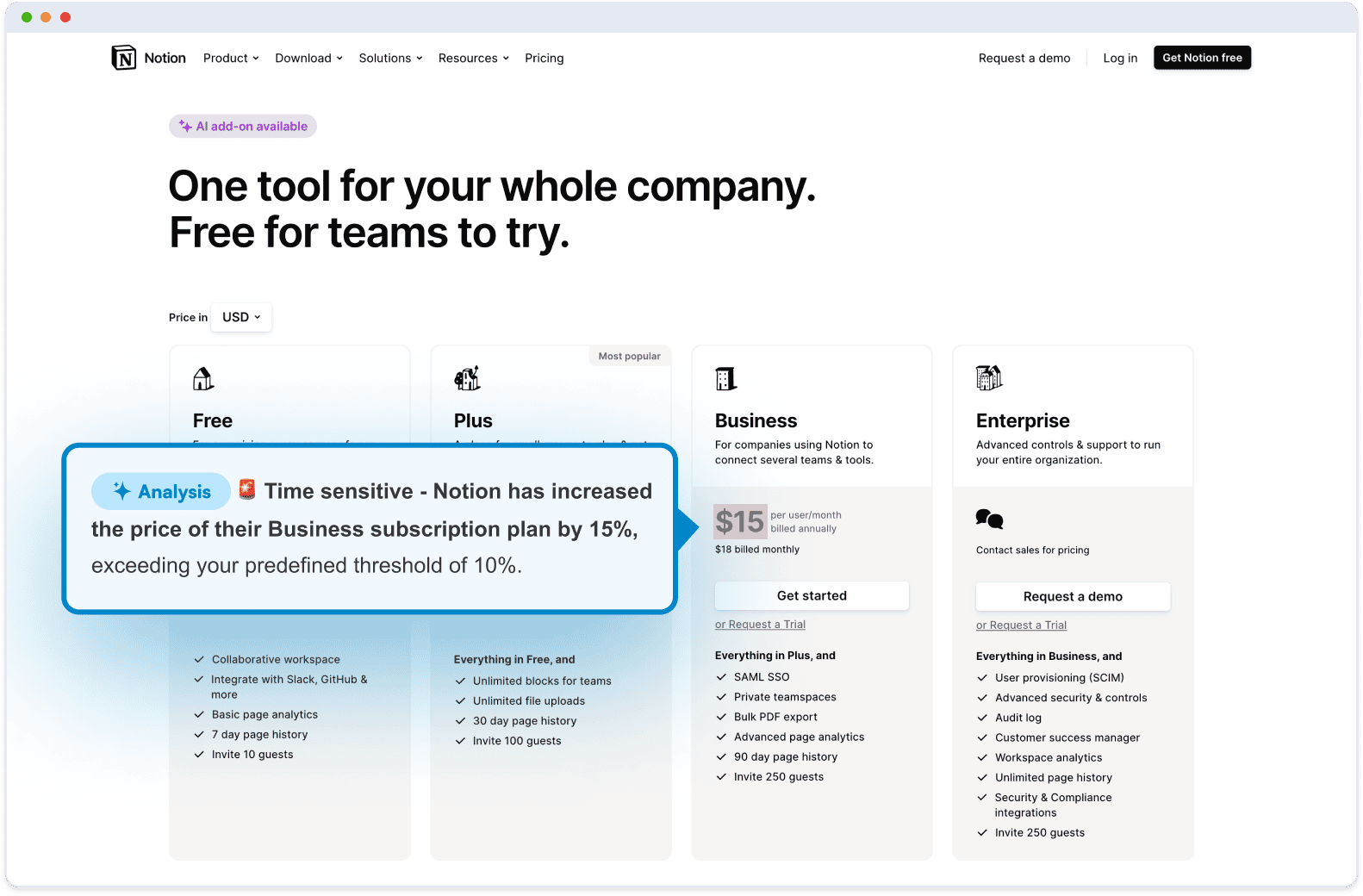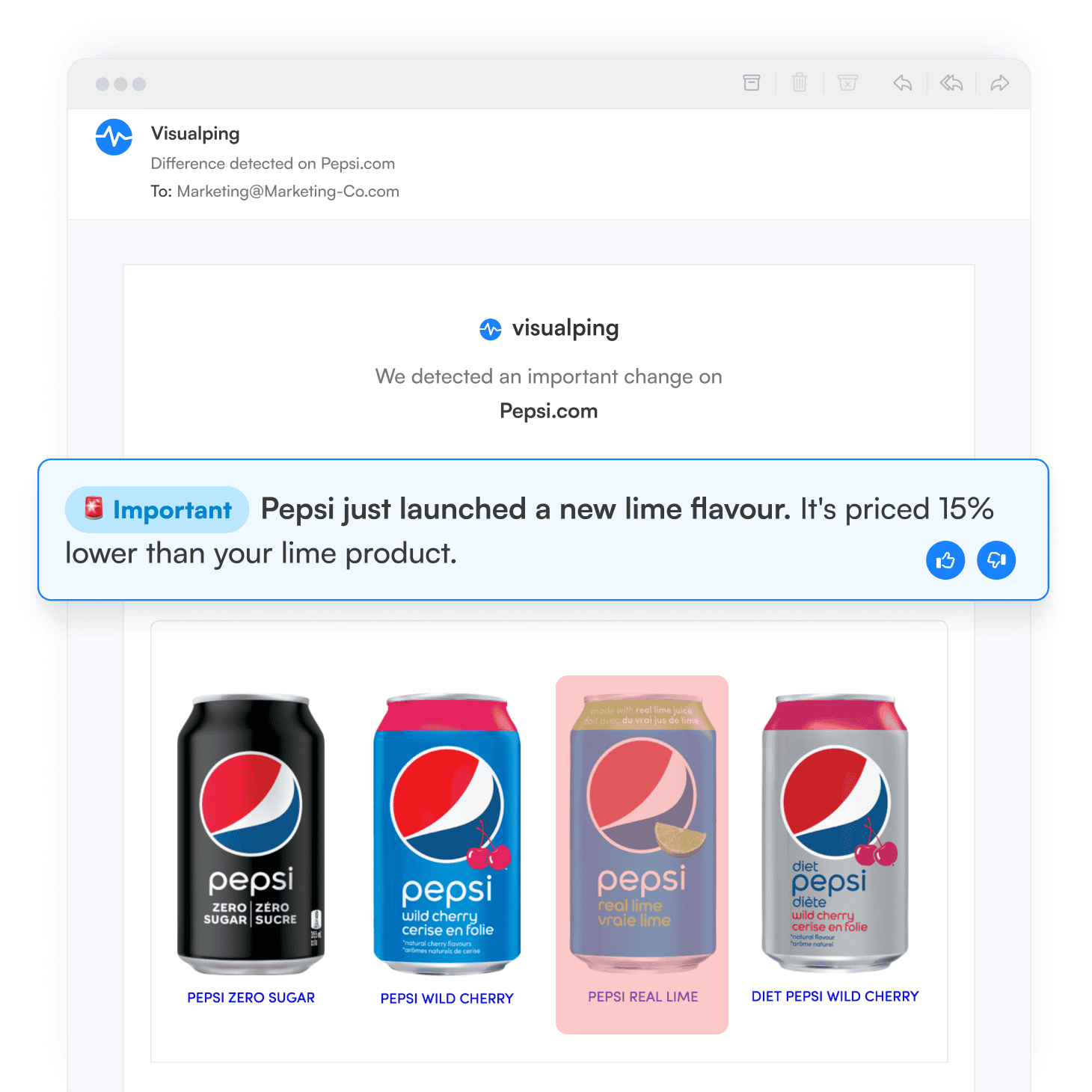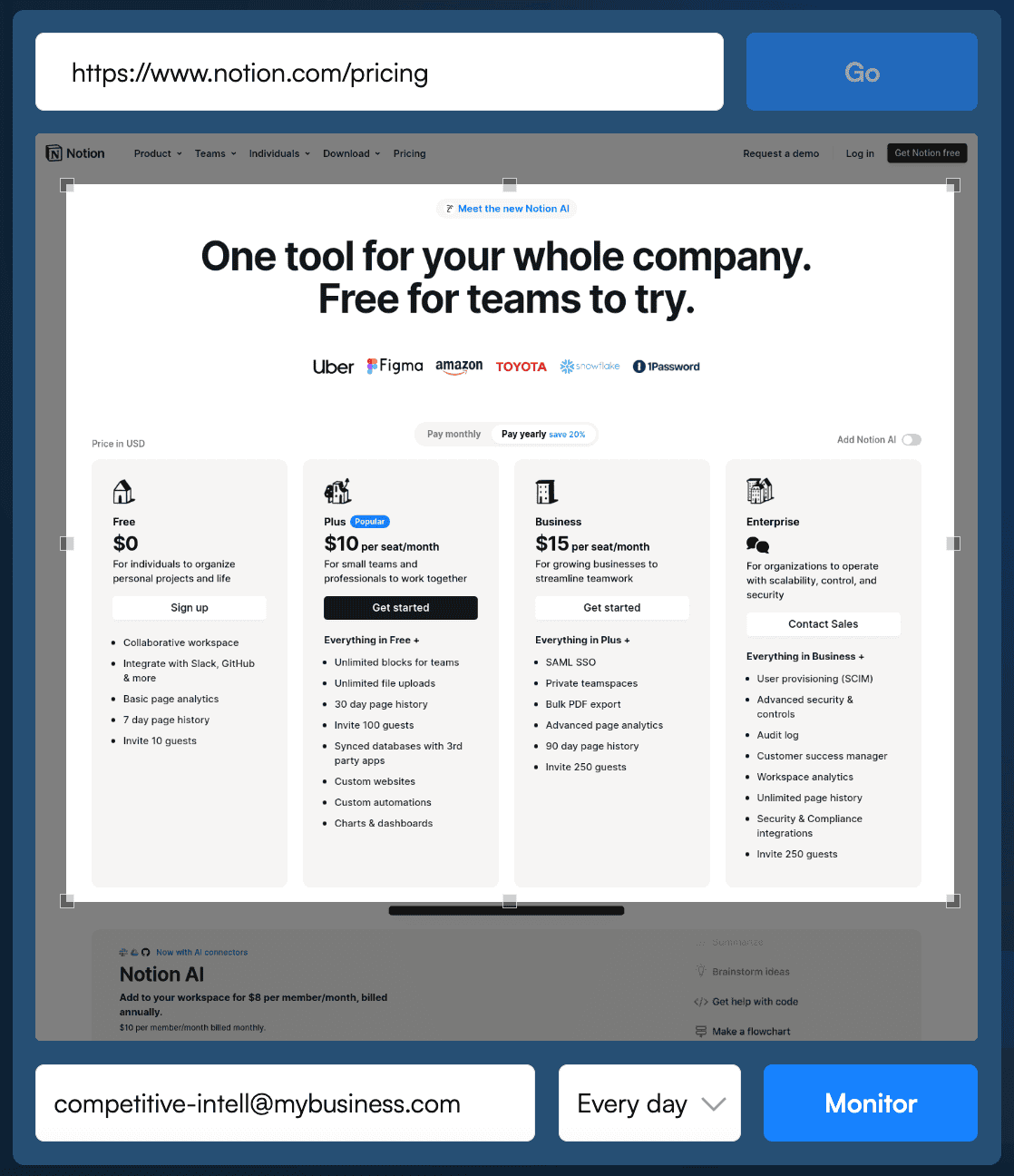What is Competitive Intelligence?
By Emily Fenton
Updated December 17, 2024

Competitive Intelligence should play a vital part in any business strategy.
But monitoring competitors for insights is more complex than a simple internet search.
In this guide, we cover what competitive intelligence is, the best sources to track online, and the top ways to spy on competitors for insights.
Competitive Intelligence, Defined
Competitive intelligence (CI) refers to the process of a company collecting, analyzing and synthesizing information about its competitors, customers and various external factors, like market trends, in a way that sharpens the company’s competitive advantage (Safe Graph).
Competitive intelligence is extremely important to any business's success. It helps businesses identify opportunities and challenges in the market landscape. This information is then analyzed to develop informed and strategic business practices.
Look ahead, scan the horizon, come up with insights, and strategize accordingly. That's competitive intelligence.
In this post, we will define what competitive intelligence is, some of the best sources for competitive intelligence, how to conduct competitive intellgence, and some of the best online monitoring tools for getting the job done efficiently and effectively.
Making a Competitive Intelligence Strategy
Competitive intelligence is carried out by ethically researching, monitoring and analyzing information from an array of published and unpublished sources.
According to ProductPlan, start with the fundamental questions: Who are our competitors? What are our target markets? What verticals are we considering entering next? These questions will provide the basis of your competitive intelligence strategy.
A team -- usually the marketing, sales or product teams -- generate competitive intelligence by painting a portrait of the external environment, so they can stay one step ahead of potential challenges and problems that may occur.
Competitive Intelligence Sources
But you can always go deeper. There's no shortage of information out there, and it's always updating.
After identifying your competitors, you need to create a list of published and unpublished sources that you can keep an eye on and monitor, to find out everything your competitors are up to. This can range from attending some of the industries biggest conferences, interviewing customers, and signing up for competitors' newsletters and email broadcasts.
These sources can also look different, depending on your job role and industry. Marketing managers, for instance, may be more likely to interview customers for research, while sales teams may be more likely to research tips on how to bid for profitable contracts.
So where's a good place to start?
Regardless of job role and industry, the best, and most obvious source of competitive intelligence is the internet. As competitors adjust their strategies, the internet is where most pivots can be spotted first. Monitoring this data is also completely ethical.
![]()
Check out this list of some rich sources of competitive intelligence, all of which you can easily find online:
- Homepages
- Product and pricing pages
- Executive Team pages
- Blog content
- Deals and promotions pages
- Key conversion pages
- Press releases
- Industry news
- Press releases
- Investor relations
- Google search result pages (ie., organic news)
- Wikipedia
- Crunchbase profile
- App store listings
- Social media bio
Tracking competitor websites, in particular, is one of the best ways to develop competitive intelligence. You can do this with an AI website tracker, like Visualping.
Competitor sites can reveal information about target audiences, shifts in marketing messages, new product releases, pricing strategies and so on. Crayon’s 2020 competitive intelligence report says 98% of businesses find monitoring competitor websites their top source of CI data.
Monitoring Competitor Websites for Competitive Intelligence
Homepages
If you’re a marketer yourself, you know a few pages on a business' website are special, critical pages. If your competitor makes an update on its homepage, then the update probably indicates something meaningful is happening on their end.

You can track their main headline or imagery, new special notices, or even subtle changes to the content, lower down the page, such as customer testimonials. You can be sure that the change you are detecting is the result of a careful decision.
Pricing and Product Pages
If your competitor offers any kind of pricing content on their website, this is the second thing to keep a close eye on. Especially in software sales, the pricing page tends to be one of those “special” pages that is created with a ton of careful thought, and only updated when something important is changing at their company.

Deals and promotions
Especially if you’re in Ecommerce, it’s generally pretty easy to locate a page or category listing that features your competitor’s latest promotions. Monitor this page to get a sense for the products they’re trying to sell off, and gain any insights for their promotional strategies.
AI-powered monitoring tools, like Visualping, are commonly used to automate the process of monitoring competitors online -- especially their website. But the tool allows you to track any web pages on the internet, for the exact information you're after.
Monitoring for Competitive Intelligence
The most efficient way to keep track of your competition online is to use competitive intelligence tools. This software helps companies automate the process of staying on top of changes online, reducing the manual, tedious labour and allowing for more effective means to keep tabs on the competition.
Competitive Intelligence Tools
Continuously keeping tabs on your competitors, while also making the best use of your time, requires more than just a simple internet search, for whenever you have the time for it. The digital age is upon us -- competitor updates occur frequently, all the time. It isn't realistic to stay on top of this data manually, nor is it an effective use of your team's time.
Without using any automated tools, gathering data for a holistic view of the competitor landscape – and then turning those insights into competitive intelligence -- becomes nearly impossible.
Visualping is an AI-powered competitor monitoring tool that can monitor updates to any web pages on the internet, for the exact competitor data you're after - such as anything you would find useful on a competitors' website.

Visualping: AI Competitor Monitoring Tool
Visualping is a popular website change monitoring tool that's commonly used for competitive intelligence.
You can automatically track competitors' websites for specific updates that interest you and your revenue teams, for example. From a competitor website, you can track competitor pricing, as well as uncover data about their products, new launches, banner advertisements, marketing strategies, team and career pages, and more.
When page changes occur, you receive an email alert that includes an AI-generated summary of the page change. it also includes a screenshot of all the web page, with the changes highlighted. Changes that were added to the page are highlighted in green. Changes that were removed are highlighted in red.

The Access Site link at the bottom of the alert takes you to the monitored page, where you can view the updates. The View Changes link takes you to your user dashboard, where you can view all your monitors -- convenient for analysis purposes.
Visualping also tracks updates to competitors’ social media pages, media mentions in news sites and research reports. Crayon's report says 76.5% of product marketers get their CI insights from reading press releases and media mentions.
Visualping offers several business subscription plans for high frequency monitoring.
Step-by-Step Guide on Getting Set Up
Step 1: Copy the URL you want to monitor, then paste it into the search field on Visualping’s homepage

The first thing to do if you want to be notified when your competitor updates a page is to get the URL for the page you want to track. Then, simply go to Visualping’s homepage and paste it in to start the process.
Step 2: Decide how often you want Visualping to check the page for changes
Next, you must decide how often you want to check the web page for changes. Choosing a higher frequency will make sure you get notified as soon as possible whenever changes occur.
Step 3: Enter the email address that you want to receive alerts
Now that you’ve told Visualping what to track and how often, you need to provide an email so you can receive notifications whenever the content is updated. Make sure to provide a valid email that you have access to so that you don’t miss a thing.
Step 4: Check your email to finish creating your new account
Finally, go to the email inbox you provided and open the verification message that Visualping sent you. It will take you to your Visualping, where you can confirm your email and activate your account.
Competitive Intelligence: That's a Wrap!
Competitive intelligence (CI) is defined as a company’s ability to collect, analyze and synthesize information about its competitors, customers and various external factors, like market trends, in a way that sharpens the company’s competitive advantage.
Companies need competitive intelligence to understand opportunities and challenges and cultivate informed business practices. Competitive intelligence tools, like Visualping are essential in order to monitor and analyze this data efficiently and effectively.
For more information about how you or your team can use Visualping for competitive intelligence, contact us.
Visualping: competitor monitoring made simple
Get targeted updates from the competition on autopilot. Trusted by 85% of Fortune 500 companies.
Emily Fenton
Emily is the Product Marketing Manager at Visualping. She has a degree in English Literature and a Masters in Management. When she’s not researching and writing about all things Visualping, she loves exploring new restaurants, playing guitar and petting her cats.